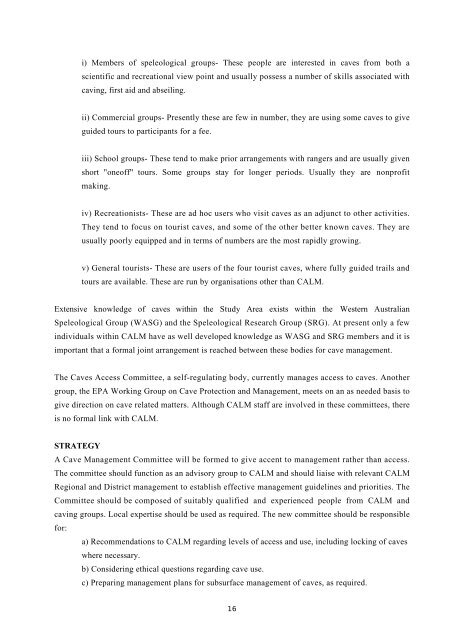leeuwin naturaliste national park management plan - Department of ...
leeuwin naturaliste national park management plan - Department of ...
leeuwin naturaliste national park management plan - Department of ...
- No tags were found...
You also want an ePaper? Increase the reach of your titles
YUMPU automatically turns print PDFs into web optimized ePapers that Google loves.
i) Members <strong>of</strong> speleological groups- These people are interested in caves from both ascientific and recreational view point and usually possess a number <strong>of</strong> skills associated withcaving, first aid and abseiling.ii) Commercial groups- Presently these are few in number, they are using some caves to giveguided tours to participants for a fee.iii) School groups- These tend to make prior arrangements with rangers and are usually givenshort "one<strong>of</strong>f" tours. Some groups stay for longer periods. Usually they are nonpr<strong>of</strong>itmaking.iv) Recreationists- These are ad hoc users who visit caves as an adjunct to other activities.They tend to focus on tourist caves, and some <strong>of</strong> the other better known caves. They areusually poorly equipped and in terms <strong>of</strong> numbers are the most rapidly growing.v) General tourists- These are users <strong>of</strong> the four tourist caves, where fully guided trails andtours are available. These are run by organisations other than CALM.Extensive knowledge <strong>of</strong> caves within the Study Area exists within the Western AustralianSpeleological Group (WASG) and the Speleological Research Group (SRG). At present only a fewindividuals within CALM have as well developed knowledge as WASG and SRG members and it isimportant that a formal joint arrangement is reached between these bodies for cave <strong>management</strong>.The Caves Access Committee, a self-regulating body, currently manages access to caves. Anothergroup, the EPA Working Group on Cave Protection and Management, meets on an as needed basis togive direction on cave related matters. Although CALM staff are involved in these committees, thereis no formal link with CALM.STRATEGYA Cave Management Committee will be formed to give accent to <strong>management</strong> rather than access.The committee should function as an advisory group to CALM and should liaise with relevant CALMRegional and District <strong>management</strong> to establish effective <strong>management</strong> guidelines and priorities. TheCommittee should be composed <strong>of</strong> suitably qualified and experienced people from CALM andcaving groups. Local expertise should be used as required. The new committee should be responsiblefor:a) Recommendations to CALM regarding levels <strong>of</strong> access and use, including locking <strong>of</strong> caveswhere necessary.b) Considering ethical questions regarding cave use.c) Preparing <strong>management</strong> <strong>plan</strong>s for subsurface <strong>management</strong> <strong>of</strong> caves, as required.16
















